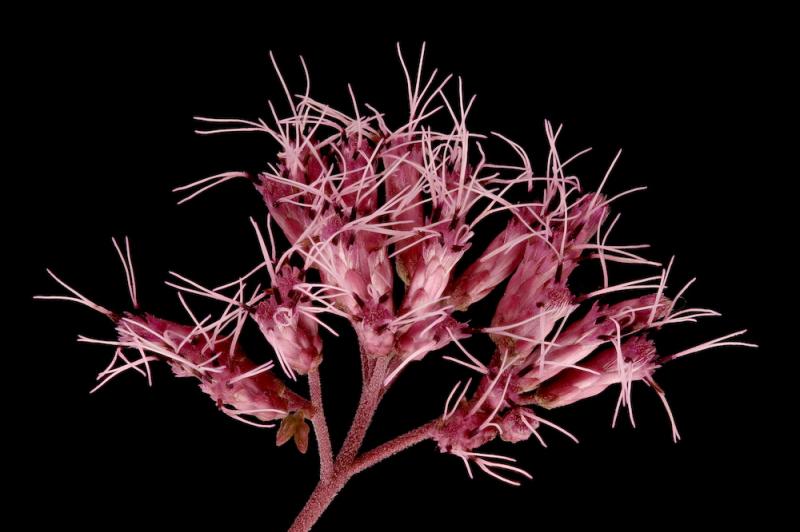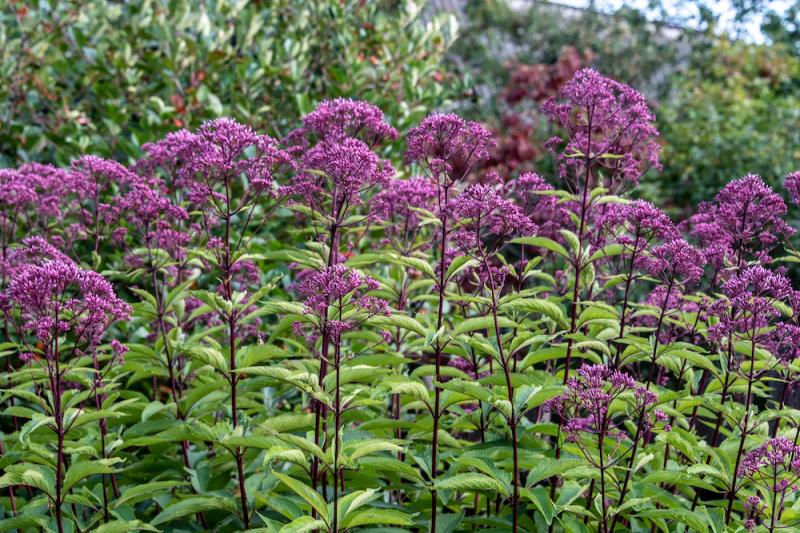
Gravel root is an example of why you should look at the Latin names of herbs and not just common names. Sometimes different common names will refer to the same species, or the same common name will be used to refer to different species. I’ve seen gravel root listed as an ingredient in commercial formulas under gravel root and two other names, Joe Pye weed and queen of the meadow. There are also three different species which have been used, Eupatorium purpureum, E. fistulosum, and E. maculatum. All three species have similar uses and are closely related to boneset, Eupatorium perfoliatum
A Remedy for "Gravel"
 Where gravel root grows is a major signature for what it does. It grows in swamps and meadows, and along waterways, where water meets the land. It can grow in gravel near the shores of streams or lakes, having a deep root system that helps keep the soil from washing away. Its major property is its ability to balance fluid and minerals within the body.
Where gravel root grows is a major signature for what it does. It grows in swamps and meadows, and along waterways, where water meets the land. It can grow in gravel near the shores of streams or lakes, having a deep root system that helps keep the soil from washing away. Its major property is its ability to balance fluid and minerals within the body.
Gravel root, like hydrangea, is a remedy that helps keep calcium and other minerals from falling out of solution to form calcium deposits and kidney stones. It’s one of the top remedies for helping to flush kidney stones or gravel and also prevents damage to the kidneys from passing sugar crystals. This makes it useful in diabetes when it is adversely affecting the kidneys. It can also be helpful for a wide variety of other kidney problems, such as edema, albumin (protein) in the urine, difficult and painful urination, cloudy urine, mucus in the urine, and scant urine.
Kidney Qi and Bones
 In Chinese medicine, the kidney energy or kidney qi is said to “build the bones.” You can see this relationship in the actions of both gravel root and boneset. Both have been used to help broken bones to heal and both may also be useful for problems with joints. Gravel root appears to help lubricate the joints and remove any calcification in places where it shouldn’t be. It can help loosen frozen or stiff joints, ease back pain or strain, and help with arthritis and bursitis.
In Chinese medicine, the kidney energy or kidney qi is said to “build the bones.” You can see this relationship in the actions of both gravel root and boneset. Both have been used to help broken bones to heal and both may also be useful for problems with joints. Gravel root appears to help lubricate the joints and remove any calcification in places where it shouldn’t be. It can help loosen frozen or stiff joints, ease back pain or strain, and help with arthritis and bursitis.
It's also been my observation that many remedies that aid the urinary system will also aid the reproductive organs. That is they will aid the genitourinary system as a whole. For example, uva ursi tea, in addition to helping with UTIs, can help heal genital infections. In keeping with this idea, gravel root has also been used for toning up the uterus and prostate. According to Matthew Wood, it can reduce prostate swelling in men and help with spotting between periods and excessive menstrual flow with periods in women. It has also been used to help prevent miscarriage.
GI Tract Remedy
 One use I was unfamiliar with when I started writing this article was the use of gravel root for the digestive organs. According to Matthew Wood, it can help GI tract infections where pus is being formed. The common name Joe Pye weed comes from a native American medicine man of that name who introduced the remedy to the European settlers as a remedy for typhoid, a bacterial infection that causes high fever, stomach pain, and constipation or diarrhea. Matthew Wood wrote that he has seen it help Crohn’s disease, the breakdown of the intestines due to gluten intolerance, and that it can be helpful for enteritis, colitis, and even peritonitis, a very dangerous infection in the abdominal cavity. That’s a very valuable piece of information to have for emergency situations where medical help for such serious problems might not be readily available.
One use I was unfamiliar with when I started writing this article was the use of gravel root for the digestive organs. According to Matthew Wood, it can help GI tract infections where pus is being formed. The common name Joe Pye weed comes from a native American medicine man of that name who introduced the remedy to the European settlers as a remedy for typhoid, a bacterial infection that causes high fever, stomach pain, and constipation or diarrhea. Matthew Wood wrote that he has seen it help Crohn’s disease, the breakdown of the intestines due to gluten intolerance, and that it can be helpful for enteritis, colitis, and even peritonitis, a very dangerous infection in the abdominal cavity. That’s a very valuable piece of information to have for emergency situations where medical help for such serious problems might not be readily available.
Gravel root is used in combinations for kidney stones and other urinary problems and formulas for healing bones and joints. It can also be obtained in tincture form from several companies. Gravel root can be found growing wild in the Eastern United States and it can also be planted in gardens and is a great herb for attracting butterflies. I hope this article and the photos have helped you appreciate the value and beauty of gravel root.
Downloads
Steven's Articles
-

-
The Evidence for Berberine
A yellow alkaloid found in traditional infection-fighting…
-

-
The Sensible Use of Caffeinated Herbs
Kola nuts, guarana, and yerba mate and other herbs…
-

-
The Health Benefits and Problems with Coffee
This popular caffeinated beverage can be beneficial…
October
-

-
Understanding Caffeine & Cellular Adaptation
Preserving the power of caffeine's buzz and the…
September
-

-
Horseradish
A pungent spice for aiding protein metabolism…
-

-
Banaba or Crepe Myrtle
A beautiful tree from Southeast Asia whose leaves…
August
-

-
Monkeyflowers
Flower essences to help see ourselves more clearly…
-

-
Mariposa Lilies
Strengthening the bond between mother and child…
-

-
The Noble Bay Leaf
A common kitchen herb for aiding digestion and…
-

-
Epimedium: Horny Goat Weed
A circulatory stimulant and kidney yang tonic…
July
-

-
The Medicinal and Nutritional Benefits of Apricots
A nutritious fruit and valuable medicinal seed for coughs
-

-
Dogwoods
Asian dogwood is used to stop excessive discharge,…
June
-

-
Neem: The Village Pharmacy
A popular Ayurvedic remedy for dental and immune…
-

-
Spilanthes: The Toothache Plant
A traditional remedy for teeth and gums, as well…
-

-
Forsythia
An anti-inflammatory, fever-reducing, and infection fighting herb

